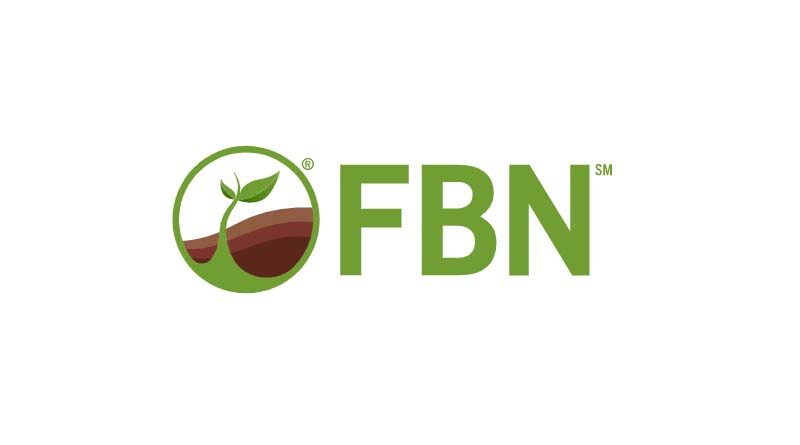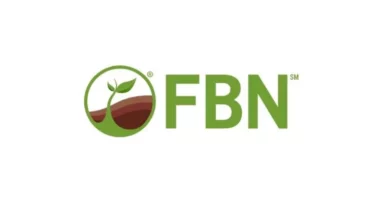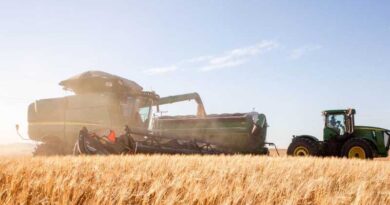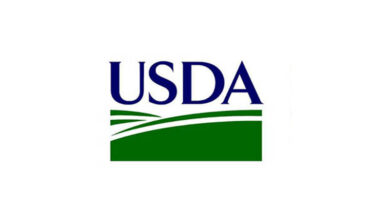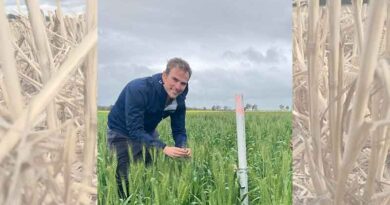Harvest Safety: Recognizing and Reducing Risks
21 September 2022, USA: Farmers face many hazards and opportunities to reduce risk on their farm, especially during harvest. Sometimes when we take a risk, we think the “stories” we hear won’t happen to us. I’d like to challenge you to think about whether you know of people, families, or communities impacted by losing a loved one on the farm.
Around this time last year my father-in-law told me about a man that had died in an accident on his farm. My father-in-law told me the man was well liked at his company and in his farming community. He entered a silo to make a repair and subsequently was found dead, submerged in grain.
Plan for a Safe Harvest
Farming takes a great deal of planning, forecasting, research and hard work in order to maximize potential profit. Farming safely requires even more effort but the outcome is significantly different; “maximizing potential” means you go home unharmed to your family each day. Below are some areas to focus on while you develop your plan for harvest.
1. Grain bins and silos
Are confined spaces with hazards that can change in the blink of an eye. Don’t work alone if you must enter them, use the buddy system. Recognize and discuss the hazards prior to performing the job. Plan for the hazards that you know are present such as:
- Suffocation from engulfment or entrapment
- Explosions due to high amounts of grain dust
- Falls from heights
- Crushing and amputation from grain equipment
2. Equipment
Should be made harvest ready at least several weeks before harvest or during the off-season. Review operation manuals and follow the manufacturer’s guidelines.
Never overlook safety labels because oftentimes they bring attention to hidden hazards such as energized areas, moving parts, or pinch points. Do not modify equipment. Are all the machine guarding and shields in place? If not, why not?
Powered-take off (PTO) injuries are common on the farm, according to the National Agricultural Safety Database (NASD), shielding is absent or damaged in 70% of the injuries. Farm workers should wear well-fitted clothing to prevent entanglement in farming equipment.
3. Overhead power-lines
Can be dangerous when working with tall equipment. Do you and your farm workers know where your overhead power-lines are? You should check for changes and sagging that may have occurred during the off-season. You can ask local utility companies to help determine the height of overhead lines on your farm.
Many types of farm equipment have risks of contacting overhead lines such as tractors with front end loaders, equipment with antennas, portable grain-augers, etc. NASD recommends if your equipment contacts an overhead like stay put and call for help.
If there is an emergency, jump as far away from the equipment as possible. Never allow any body part to touch the equipment and the ground at the same time. Do not get back on the equipment until the utility company has removed the hazard.
4. Corn pickers, combines, tractors
Are big machines with lots of moving parts. Do you know what types of equipment can cause serious injuries on your farm? If corn pickers and combines are clogged, train farm workers to turn the equipment off, ensure it’s fully stopped, then attempt to free debris.
Inform workers of pinch points where clothing, fingers, and legs can get caught. Always use the handrails to mount and dismount the equipment. Keep the steps free of dirt to avoid slips and falls. Do you have wells, equipment, gates, above ground pipelines, etc. marked to ensure safe turning of your equipment?
Tractor accidents in farming tend to lead to serious if not fatal injuries. According to the Occupational Safety and Health Administration (OSHA), “An operator’s chance of surviving a tractor turnover without a serious injury is good if the tractor has a roll-over protective structure (ROPS) and the operator is wearing a seat belt.”
5. Agricultural equipment on public roads
Have Federal and State regulations. You must know the specific regulations you are required to meet for lighting and marking prior to getting on public roads. New agricultural equipment that will be operated on a public road must meet standards set forth in ANSI/ASAE 279.14 JUL2008 “Lighting and Marking of Agricultural Equipment on Highways.”
Some additional things to plan for prior to getting farm equipment on roads are:
- Can the equipment be moved on public roads during daylight hours to avoid driving in the dark?
- Do you know the towing capacity of your equipment, correct hitches and chaining?
- Weight and towing affects speed. Have you communicated that with all drivers?
- Plan and discuss dual brake pedals, climbing and descending hills, lane usage, etc. Don’t assume that your workers know how to safely drive on public roads.
6. Feeling tired
Stop and take a break. If you’re not getting enough sleep it can become a safety hazard. When you’re tired your reaction time is slower, you can have trouble remembering things, and are at risk of falling asleep on the job. Several studies show lack of sleep and being tired can be compared to being drunk. NIOSH posted a study that states being awake for 17 hours is similar to having a blood alcohol content of 0.05%.
7. Hydration and good nutrition
Is vital to keep yourself healthy during harvest. Eating small snacks, not skipping meals, and staying hydrated is important. Implementing these habits during harvest will provide continuous energy to cope with busy, stressful, and long workdays. Don’t forget your sleep!
8. Additional safety topics to consider for harvest
- Adequate lighting during pre-dawn and after dusk activities.
- Temperatures still get high during Fall months. Plan to bring enough water for the day, even though the mornings may be cooler.
- Have a plan for equipment breakdowns and maintenance.
- If you are working alone, always be sure someone knows where you will be during the day. Have a plan if you are injured or equipment breaks down.
- Have personal protective equipment purchased and ready. For example, respirators that meet NIOSH N95 requirements to prevent inhalation of grain dust.
- Clear debris from roads on your farm. Check your roads for potholes and ruts that can unbalance heavy equipment.
- Make sure there is supervision for children during this busy time.
Stay safe this harvest. You are someone’s child, parent, or grandparent. No job is so important and so urgent it can’t be done safely.
Also Read: Arrival of soybean in Mandsour Mandi improves; average rate lower than last year but above MSP
(For Latest Agriculture News & Updates, follow Krishak Jagat on Google News)

